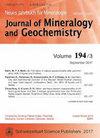伊朗伊斯法罕西北部蒂朗盆地沉积型锌铅(±Ag±Cu)矿床地球化学、流体包裹体研究及成因
IF 0.8
4区 地球科学
Q4 MINERALOGY
引用次数: 13
摘要
伊朗Tiran盆地位于Malayer-Esfahan成矿带(MEMB)南段,在早白垩世沉积序列的黑色灰质粉砂岩和碳酸盐岩中含有大量泥页岩型Zn-Pb(±Ag±Cu)硫化物矿床。该层序沉积于sanandaji - sirjan带与伊朗中部微大陆之间的伸展弧后环境。Tiran盆地由6个沉积型铅锌矿床(Anjireh-Chekab、Vejin-Bala、Vejin-Paein、Sefidkhal、Khaneh-Sormeh和Kope-Motaleb)组成,估计总储量为1000万吨,含4% Zn、2% Pb、0.2% Cu和20ppm Ag。根据矿石的几何形状、矿物学特征和硫化物矿化结构特征,可将矿床划分为三种不同的矿相:给矿带、块状矿相和广泛的带状替代硫化物矿相。硅化、白云化和绢云母化是主要的围岩蚀变类型;向送料带方向变化强度增大。寄主岩石的高V/ (V+Ni)值(> 0.6),细粒碎屑沉积物中有机质和草莓状黄铁矿的存在表明寄主盆地发生过缺氧事件。用显微测温方法研究了与块状和带状替代矿相有关的粗粒闪锌矿和与硫化物矿物同生的热液方解石、白云石和石英中的流体包裹体。基于流体包裹体组合(FIAs),均一温度从靠近同沉积正断层的给矿带(172°C ~ 284°C,相对205.6°C),通过块状矿石(157°C ~ 270°C,相对195°C)到带状替代矿石(115°C ~ 270°C,相对172°C)逐渐降低。这种变化与盐度从4.4到5.1到6.3 wt.% NaCl当量以同样的方式增加有关。这一趋势被解释为在带状替代矿相的海底松散沉积物中,矿流体与咸水混合。流体包裹体数据表明,与密西西比河谷型(MVT)和爱尔兰型(Irish-type)矿化相比,Tiran页岩含锌铅矿更接近于喷口-近端沉积-喷发型(SEDEX)和VMS矿床。然而,地质数据、矿相和成矿过程与海底替代SDEDX矿床相一致,该矿床已被建议用于一些大型SEDEX或页岩型锌铅矿床,如阿拉斯加的Red Dog和Anarraaq以及澳大利亚的Century矿床。本文章由计算机程序翻译,如有差异,请以英文原文为准。
Geochemistry, fluid inclusion study and genesis of the sediment-hosted Zn-Pb (± Ag ± Cu) deposits of the Tiran basin, NW of Esfahan, Iran
The Tiran basin in the southern part of the Malayer-Esfahan metallogenic belt (MEMB), Iran, contains numerous shalehosted Zn-Pb (± Ag ± Cu) sulfide deposits in black limey siltstone and carbonate rocks of the Early Cretaceous sedimentary sequence. This sequence deposited in an extensional back-arc environment between the Sanandaj-Sirjan Zone (SSZ) and Central Iranian microcontinent. The Tiran Basin consists of six sediment-hosted Zn-Pb deposits (Anjireh-Chekab, Vejin-Bala, Vejin-Paein, Sefidkhal, Khaneh-Sormeh and Kope-Motaleb) with estimated total reserves of 10 Mt at 4 % Zn, 2 % Pb, 0.2 % Cu and 20 ppm Ag. Based on geometry of ores, mineralogy, and texture of sulfide mineralization, three different ore facies can be distinguished in these deposits: feeder zone, massive ore, and extensive banded replacement sulfide ore facies. Silicification, dolomitization and sericitization are the main wall-rock alteration styles; alteration intensity increases toward the feeder zones. The high V/ (V+Ni) values (> 0.6) of the host rocks, and presence of organic matter and framboidal pyrite within fine-grained detrital sediments suggest an anoxic event for the host basin. Fluid inclusions in coarse-grained sphalerite, related to massive and banded replacement ore facies, and hydrothermal calcite, dolomite and quartz that are cogenetic with sulfide minerals in the main stage of mineralization, were studied by microthermometry. Based on fluid inclusion assemblages (FIAs), the homogenization temperatures decrease from the feeder zone (172 °C to 284 °C, av. 205.6 °C) adjacent to the synsedimentary normal faults, through the massive ore (157 °C to 270 °C, av. 195 °C) to the banded replacement ore (115 °C to 270 °C, av. 172 °C) facies. This variation is associated with an increase in salinity from 4.4 through 5.1 to 6.3 wt.% NaCl eq. in the same way. This trend is interpreted to represent mixing of ore fluids with saline seawater at the sub-seafloor unconsolidated sediments in the banded replacement ore facies. Fluid inclusion data show that the Tiran shalehosted Zn-Pb deposits are more like the vent-proximal sedimentary-exhalative (SEDEX) and VMS deposits than other sedimenthosted Zn-Pb deposits, such as Mississippi Valley Type (MVT) and Irish-type mineralizations. However, geological data, ore facies and ore forming processes is compatible with a sub-seafloor replacement SDEDX deposit that has been suggested for some large SEDEX or shale-hosted Zn-Pb deposits such as Red Dog and Anarraaq in Alaska and Century deposit in Australia.
求助全文
通过发布文献求助,成功后即可免费获取论文全文。
去求助
来源期刊
CiteScore
0.90
自引率
20.00%
发文量
6
审稿时长
>12 weeks
期刊介绍:
Neues Jahrbuch für Mineralogie (Abhandlungen) publishes thorough, detailed studies of up to 30 printed pages as well as short and concise papers and notes (less than 15 printed pages) on mineralogy, i.e. crystallography, crystal chemistry, petrology, geochemistry and economic mineralogy (mineral deposits).
All fields of mineralogy: crystallography, crystal chemistry, petrology, geochemistry and economic mineralogy (mineral deposits).

 求助内容:
求助内容: 应助结果提醒方式:
应助结果提醒方式:


